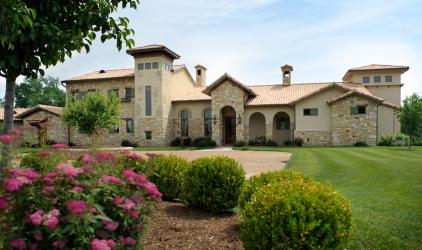Long before the Roman Empire, the central portion of Italy was occupied by the Etruscans, an ancient but remarkably sophisticated civilization. Known today as Tuscany, this stunningly beautiful region has retained its unique character for centuries and continues to delight tourists with its sun-drenched hillsides, quaint villages, vineyards and fields of lavender and sunflowers.
Early Etruscans built their structures with whatever materials were locally available—predominately wood and, later, incorporating limestone and shale. Although subsequently influenced by Roman and Medieval design, the rural architecture of Tuscany remained consistently simple—balanced and sturdy, with clean lines, natural materials, earthen colors and an informal, rustic ambience.
During the Renaissance, Venetian architect Andrea Palladio designed some of the first Italian villas, incorporating various classical motifs into residential architecture, and by the mid-19th century, the romantic “Italian villa look” had taken Victorian England by storm. Quickly making its way to America, this idealized form was labeled “Italianate” and became the preferred home design until the 1870s, capturing the imagination of some of St. Louis’s most famous business tycoons, several of whose mansions are still standing.
Elegantly casual and easily recognizable, contemporary Tuscan styling synthesizes the drama of Old World design with today’s latest lifestyle trends. Structural elements typically include two to three stories, low-pitched roofs and overhanging eaves (often covered with terracotta barrel tiles), elongated, arched windows and doorways, square towers or cupolas and porches topped with balconies enclosed by balustrades.
Exteriors are usually clad with stucco and natural stone or brick, sometimes with a rosy hue reminiscent of the reddish limestone common to Tuscany. Even more villa-like, the entry may be surrounded by a courtyard with stone walls and perhaps a wrought-iron gate. Harking back to the Etruscans, natural wood (weathered, distressed or carved, but never painted) continues to be the authentic material for entry doors, shutters, interior beams and furnishings. Other traditional accents might include classical moldings, brackets and cornices, cast-iron hardware and railings, window boxes and copper gutters.
It’s easy to understand why Tuscan styling remains a favorite with today’s homeowners. Interiors emphasize high, vaulted ceilings, large, open spaces—particularly kitchens, massive fireplaces, exposed wood beams, stone, marble and wood plank floors, textured plaster walls, decorative tiles and a palette of brick reds, olive greens, golds and tans. Villa design also seeks to blur the distinction between outdoors and indoors, particularly in the warmer climates of the West Coast and Texas, where gardens, landscaping, planters, fountains, benches and even statuary extend the peaceful, relaxing environment beyond the walls of the home.
Century after century, Tuscan design has never lost its focus. More than simply an architectural genre or style of decorating, it’s a way of life—la bella vita—warm and welcoming, superbly comfortable, family-oriented and evocative of one of the most picturesque and idyllic places on earth.





